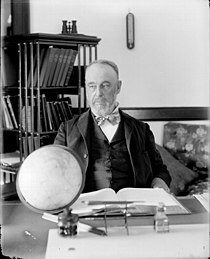Asaph Hall
| Asaph Hall | |
|---|---|

Asaph Hall at the USNO in 1899
|
|
| Born |
October 15, 1829 Goshen, Connecticut |
| Died | November 22, 1907 (aged 78) Annapolis, Maryland |
| Residence | United States |
| Nationality | American |
| Alma mater | New-York Central College, McGrawville |
| Occupation | Astronomer |
| Known for | Discovery of two Martian moons |
| Parent(s) | Asaph Hall II Hannah Palmer |
Asaph Hall III (October 15, 1829 – November 22, 1907) was an American astronomer who is most famous for having discovered the moons of Mars, Deimos and Phobos, in 1877. He determined the orbits of satellites of other planets and of double stars, the rotation of Saturn, and the mass of Mars.
Strangely enough, the two moons of Mars had already been described 103 years earlier by Jonathan Swift in his 1726 novel Travels into Several Remote Nations of the World, also known as Gulliver's Travels. In his reference to the astronomers of Laputa in Chapter III, Swift states: "They have likewise discovered two lesser stars, or satellites, which revolve about Mars; whereof the innermost is distant from the centre of the primary planet exactly three of his diameters, and the outermost, five; the former revolves in the space of ten hours, and the latter in twenty-one and a half; so that the squares of their periodical times are very near in the same proportion with the cubes of their distance from the centre of Mars; which evidently shows them to be governed by the same law of gravitation that influences the other heavenly bodies."
Hall was born in Goshen, Connecticut, the son of Asaph Hall II (1800–42), a clockmaker, and Hannah Palmer (1804–80). His paternal grandfather Asaph Hall I (June 11, 1735 – Mar. 29, 1800) was a Revolutionary War officer and Connecticut state legislator. His father died when he was 13, leaving the family in financial difficulty, so Hall left school at 16 to become an apprentice to a carpenter. He later enrolled at the Central College in McGrawville, New York, where he studied mathematics. There he took classes from an instructor of geometry and German, Angeline Stickney. In 1856 they married.
In 1856, Hall took a job at the Harvard College Observatory in Cambridge, Massachusetts, and turned out to be an expert computer of orbits. Hall became assistant astronomer at the US Naval Observatory in Washington DC in 1862, and within a year of his arrival he was made professor.
...
Wikipedia
